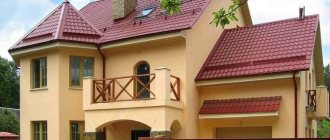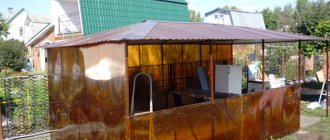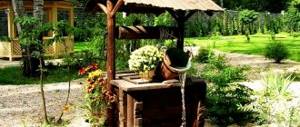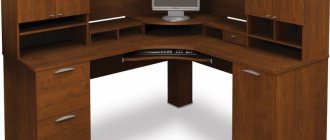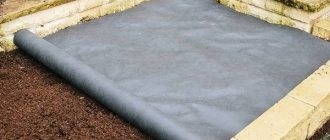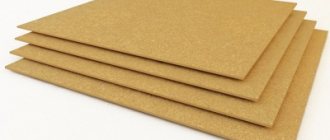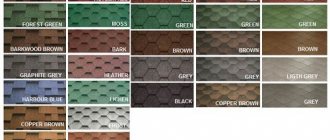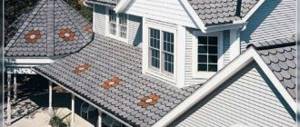Advantages of Ondulin over other roofing materials
| The main function of any roof is to protect against moisture penetration into the house. Ondulin is one of the most reliable materials in this regard. With proper installation, following all instructions, Ondulin will never leak. If we compare other roofing materials, Ondulin: DOES NOT leak, DOES NOT rust, DOES NOT condense, DOES NOT peel paint, DOES NOT contain asbestos, DOES NOT make noise when it rains, DOES NOT get hot, is lighter. |
The structure of ondulin and its main characteristics
Frankly speaking, ondulin does not even exist, since this name is not official, but a common noun, like “copier,” that is, the name of the company that first produced this roofing material 60 years ago. The correct name is euro slate or corrugated bitumen sheet. It consists of waste paper, which is pressed under high heat and impregnated with bitumen. That is why the price for a sheet of ondulin is so affordable.
For greater strength, the sheets are given a wave shape and painted with acrylic in any color. The palette is not rich, but in the end, Euro slate noticeably wins over the gray sheets of regular slate. In addition, it is environmentally friendly, since there is no asbestos contained in the same slate in ondulin. The main characteristic that makes it worth buying ondulin is its high moisture resistance. Having received minor damage (cracks, scratches), the cellulose fibers themselves are soldered in the heat, since the material is quite plastic when heated.
Color spectrum
Ondulin sheets are painted before impregnation with bitumen, which makes their color stable.
| Red | Green | Brown | Black |
Advantages of using ondulin as a roofing material
By choosing ondulin as a roofing material, you can make a very high-quality and durable roof covering in a short period of time. With such a roof covering, the owner of the house can be confident in its good condition for several years and does not have to worry about repairs.
Covering the roof with ondulin will allow the owner of the house:
Using the detailed instructions, you can independently handle the installation of ondulin;
save on roof repairs, since using ondulin you don’t have to remove the old coating;
• do not worry about the weather during repairs, since the untouched old covering will be able to protect the roof from rain;
• old roof covering, which is not dismantled during repairs, and ondulin laid on top of it will improve the thermal insulation of the roof;
• choose the color of the material you like and make the appearance of the roof covering attractive.
Main properties of Ondulin
ONDULIN - does not leak. The guarantee for the moisture resistance of the sheets is 15 years, the service life reaches 50 years.
ONDULIN does not contain asbestos and is an environmentally friendly material. ONDULINA sheets are fully certified, having a Russian hygienic certificate, as well as a certificate of conformity and a fire safety declaration.
ONDULIN is resistant to various climatic conditions, withstanding both tropical sun and Siberian frost.
During the entire time of using Ondulin, it, like everything under the sun, fades slightly. This becomes noticeable in the first months of operation. However, the color changes are almost invisible to the eye. After the first rains the color stabilizes.
Roofing made from ONDULINA can withstand significant snow and wind loads when properly lathed.
Technical characteristics of ondulin
- Service life: if you rely on manufacturer warranties, a bitumen roof should last 15 years without problems. In fact, this period can increase to 50 years, subject to compliance with operating rules.
- Fire resistance: Euro slate is a flammable material. Ignition temperature is 250 - 300 degrees. This parameter somewhat limits the scope of ondulin. For example, when constructing public buildings (schools, preschool institutions and clubs, etc.), it will be necessary to either abandon this material or provide fire barriers to localize fires and protect the remaining structures of the building from fire
- Overall dimensions of the ondulin sheet: length - 2000 mm; width - 960 mm; material thickness - 3 mm; wave height - 36 mm; wave pitch - 95 mm
- The weight of one sheet of bituminous shingles is only 6.5 kilograms: it is not the last among lightweight roofing materials
- The useful area of a sheet of bitumen shingles ranges from 1.29 to 1.56 square meters in accordance with the slope of the roof slope
Technical characteristics of ondulin
Physical properties of ondulin
- Strength: this parameter for ondulin is: not less than 1800 kPa according to the NFQ 03-054 standard; not less than 170 kPa/m according to the OFIC standard.
According to test results at a load of 960 kgf/sq. m ondulin retains its integrity. It makes no sense to test the material for a higher load, since at 960 kgf/sq. m, the roof truss system is destroyed. The high strength properties of ondulin allow it to withstand significant snow loads and hurricane winds. The only note is that you should not use ondulin when the roof slope is less than 10 degrees. This will lead to additional costs for the installation of continuous sheathing and an increase in the consumption of roofing material due to an increase in sheet overlaps.
- Heat resistance: without load, ondulin retains its shape when heated to 110°C
- Noise insulation: this figure, according to DIN 52210, reaches 40 dB. The soundproofing properties of ondulin are its absolute advantage compared to metal tiles
- Thermal conductivity: this indicator for ondulin is low. According to DIN 52612 it is only 0.19 - 0.2 Kcal/mh°C
- Frost resistance: ondulin is a frost-resistant roofing material. During testing (cyclic freezing/thawing in water to a temperature of -25 degrees), no damage or changes in the geometric parameters of the sheet were detected
However, it should be taken into account that at low temperatures, bitumen shingles become brittle, and at high temperatures - over 30 degrees - it softens. These nuances should be taken into account when installing the roof: work should not be carried out if the thermometer drops below zero or exceeds +30°C. But this only applies to installation: roofing made from ondulin can be used in the temperature range from -40°C to +50°C.
- Environmental safety: Ondulin does not pose a threat to human health and cannot harm the environment. Rainwater flowing from the roof can be used for drinking by animals and watering plants. The smell that bitumen impregnation emits in hot weather is somewhat alarming - but it’s just a smell, it’s not harmful
- Color fastness: high-quality ondulin retains its original color for a long time. Its rapid fading in the sun is evidence of a violation of the European slate manufacturing technology.
By the way, defective ondulin not only loses color - it can also delaminate, and fungus nestles on its surface and rapidly multiplies. It is difficult to determine a defect visually, so the buyer should carefully choose the seller. It is better to purchase material from a supplier who has been known on the market for at least ten years and values its reputation.
Of course, with such characteristics, ondulin is a good roofing material.
However, we should not forget that the modern market is not limited to it; there are metal tiles, corrugated sheets and others. What is better: ondulin or metal tiles? It all depends on what is more important to you. If fire safety is a concern, then you should definitely choose metal tiles. Also, after reading this article, you can find out which is better: ondulin or corrugated sheeting? The detailed technical characteristics of each material will help you make the right choice.
Color range and price
Ondulin, unlike metal tiles, cannot boast of bright colors. Its color range is not rich, the sheets are painted in discreet shades of red, green, brown and black. However, you can see many cottages where the color and texture of the facades are in perfect harmony with the color of the ondulin roof.
Although price does not relate to the operational or technical characteristics of ondulin, this factor is one of the decisive ones when choosing a roofing covering. Ondulin with the appropriate technical characteristics has a price from 320 to 430 rubles per sheet, which may also vary depending on the color you choose.
Main technical parameters
| Characteristic | Unit measurements | Magnitude | Tolerance |
| Length, L | mm | 2000 | +10 -3 |
| Width, B | mm | 960 | ±5 |
| Total thickness,S | mm | 3.00 | ±0.2 |
| Wave pitch, t | mm | 95 | ±2 |
| Wave height, H | mm | 36 | ±2 |
| Weight | kg | 6.5 | ±0.3 |
| Number of waves | — | 10 | — |
| Effective area | sq.m. | 1.29 / 1.54 / 1.56 (depending on the roof slope) | — |
Specifications and prices
Sheet dimensions:
- width 95 cm;
- wave height 3.6 cm;
- length - 200 cm;
- thickness - 3 mm.
As already mentioned, ondulin sheets are lightweight, only 6 kg .
This gives it an advantage during installation, since additional expensive devices are not required. As you know, this material has many advantages, and besides the quality, the price is also pleasing. The average price for the material is 390−450 rubles per sheet (the cost may vary depending on the color).
If you take into account the dimensions of the sheets: 2x0.95 m, you can roughly calculate how much the entire roof will cost you.
Main characteristics of the material
Ondulin is made from cellulose with mineral fillers. Thermosetting resin and distilled bitumen are used to impart rigidity and water resistance to the cellulose fiber, allowing the material to withstand even extreme loads. The surface of the finished sheets can be painted in different colors. You can view the types and colors of the material on the website.
This technology has made it possible to create an environmentally friendly material that will serve for many years and can withstand significant wind and snow loads. What distinguishes ondulin from other modern roofing materials is:
- Light weight.
- High wear resistance.
- Durability of the repair-free period of roof operation.
- Good thermal and noise insulation properties.
- Resistance to negative climatic factors.
- Low water absorption.
- Various colors - red, brown, black and green.
Ondulin sheet size
Ondulin is produced in two types - as slate or tile. They differ in appearance and leaf size. Performance characteristics remain unchanged. The size of an ondulin sheet, which looks like a tile, is usually somewhat smaller. Therefore, most often the installation of ondulin of this type is in demand when arranging a roof with a complex configuration. After all, the use of small sheets allows you to reduce the amount of waste. When arranging a simple roof, ondulin in the form of slate is more suitable.
The size of a standard sheet of material is 950x2000 mm. There are 10 waves on this area, and the dimensions of each are approximately 9.5x20 cm. When calculating the material for the roof, it is necessary to take into account not only its total area, but also the fact that additional elements are used during its arrangement.
In order to calculate the material, you need to take into account the actual size, and not the overall size. Ondulin is laid with an overlap, which means that the actual size will be smaller than the overall size by the amount of overlap. For each sheet of ondulin, this difference is about 0.3 square meters. m. Considering that the overlap during installation is carried out both in length and width, the actual size of the ondulin sheet will be 864 × 1900 mm. Accordingly, the area of the sheet after installation work will be reduced to approximately 1.6–1.64 square meters. m.


